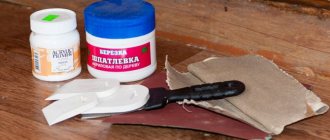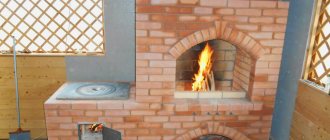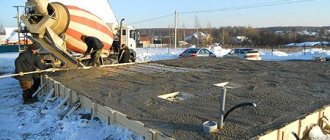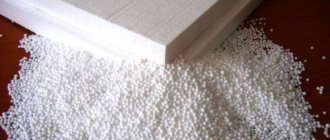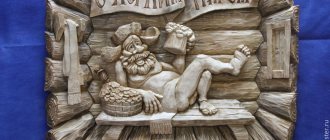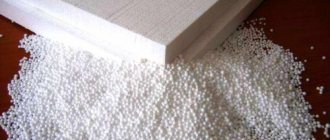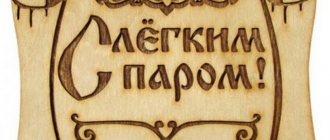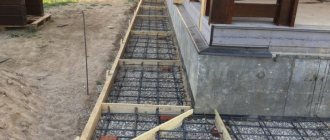In most cases, foam plastic is used to insulate private houses and industrial buildings. This material has excellent thermal insulation properties and a high level of environmental friendliness. In addition, it is resistant to bad weather conditions. Insulating a private home using polystyrene foam will cost 1.5-2 times less than insulating using other materials. Expanded polystyrene can be easily cut, drilled and glued.
Polystyrene foam is used to insulate private houses. It is a highly environmentally friendly material that remains resistant to temperature changes.
The material is made from polystyrene granules. It can be obtained by foaming with warm air. Polymer granules, which turn into thin capsules measuring 5-10 mm, are formed by extrusion into small blocks of the required thickness or designs in the form of various shapes. The ratio of polymer and air can be from 1:30 to 1:10. Thanks to this, it is possible to obtain materials of different densities.
The advantage of polystyrene foam is saving material consumption.
The advantages of polystyrene foam include the following:
- The material is chemical and moisture resistant.
- Does not swell in water.
- Not affected by mold and mildew.
- Durable.
- Resistant to temperature changes.
- Combusts only on contact with open flame.
Disadvantages of the material:
- Destroyed under the influence of carbon solvents.
- When ignited, produces a large amount of smoke.
- During combustion, it releases toxic substances.
Main characteristics of polystyrene foam
Before gluing to a wooden, concrete or brick surface, as well as when deciding how to glue the foam together, you need to learn about the properties and characteristics of this material. Polystyrene foam, or, as it is otherwise called, expanded polystyrene, is formed as a result of foaming polymers. 98% of the material is gas, located in tiny cells with very thin walls.
Typically, foam boards are used as insulation for the walls of building facades and for finishing ceilings, walls, slopes indoors, in basements, on balconies and loggias. Expanded polystyrene can be glued to concrete, wood, metal, brick, plasterboard and gas silicate bases.
Main characteristics of polystyrene foam:
- excellent rigidity with low weight;
- long service life;
- excellent thermal insulation properties;
- resistance to moisture;
- expanded polystyrene with fire retardants does not burn;
- does not pollute the environment when disposed of after use;
- protects from wind if used outside the building;
- does not emit substances harmful to the human body; you can work with this material without protective equipment;
- does not dry out or shrink during long-term use, is resistant to temperature changes;
- It is easy to work with polystyrene foam - it is not difficult to cut, installation can be carried out using improvised means;
- mold fungi do not develop on it;
- inexpensive.
Using expanded polystyrene as an insulation material instead of wood, brick, concrete or mineral wool saves time, money and space indoors.
Polystyrene foam has disadvantages:
- breaks easily;
- has very poor breathability;
- is destroyed by the action of mixtures that include nitro varnish;
- deforms when solvent and ultraviolet rays hit the surface.
Features of the material
The basis of the material is polystyrene. It foams in production. This technology is often used, for example, in the manufacture of isolon and other insulators. Granular plastic is treated with water steam. As a result, the granules increase in volume, filling with air, and stick together. The result is a light, fairly strong mass consisting of 95% air. Therefore, expanded polystyrene, as it is also called, has good insulating characteristics. It traps heat and sound waves.
Its surface is quite dense, suitable adhesive paste fits well on it. But some products don't stay on smoothly. They cannot be used. When cutting, poorly held granules may fall out. Then a torn cut is formed, which is very difficult to glue smoothly. This must be taken into account when cutting. It is better to use a thermal cutter or a very sharp knife.
Methods of gluing and types of adhesive compositions
You can attach foam boards to the surface using glue, dowels, or both. Foam plastic is usually attached with adhesive compounds indoors, and with dowels and glue - when working on the facade. Fixation only with dowels is used in extremely rare cases, this is explained by the fact that the required level of reliability cannot be achieved in this way. If the roof is insulated, then expanded polystyrene is simply inserted into the sheathing.
Foam gluing is carried out using dry compounds and ready-made adhesive mixtures.
Advantages of powdered products:
- excellent adhesion (adhesion) to brick, plaster, concrete, cement;
- immunity to temperature changes and precipitation;
- elimination of small irregularities on surfaces;
- relatively low cost.
Disadvantages of dry mixes:
- the adhesive composition must be prepared, this will take time, in addition, you need to know how to properly combine the powder with water in order to achieve a uniform consistency;
- You will need a mixing container and a construction mixer;
- Dust is released during the cooking process.
Ready-made adhesives will allow you to quickly and efficiently glue polystyrene foam to polystyrene foam, concrete, brick and wood surfaces, OSB panels or cellular blocks. Aerosols are most often used in cans based on polyurethane foam. Such materials are very convenient, and one cylinder is enough to glue approximately 10 m 2 of foam plastic boards inside or outside the building. The glue is resistant to temperature changes and high humidity, hardens in about half an hour and securely attaches the foam to the base.
Penosil polyurethane foam
Important Never use mixtures that contain toluene, alcohol or acetone for gluing foam plastic, as they destroy the structure of the material. The disadvantage of ready-made adhesives is their high cost. Popular ready-made adhesive mixtures:
When deciding how to glue polystyrene foam, you should not write off other ready-made adhesives, for example:
- silicone sealant is used if it is necessary to fasten small fragments of thin foam to a leveled base;
- “liquid nails” is a universal adhesive composition made on the basis of polymers. For example, “Installation Moment”, Dragon, which perfectly connects a metal base with foam. They are convenient for gluing polystyrene foam to the ceiling.
Advice Before gluing, clean the metal surface from rust, grease and paint.
Thermal insulation adhesive Tytan Styro 753 O2
Properties of foam plastic boards
There are a number of other materials that can retain heat in the house and isolate the room from unwanted sounds. However, polystyrene foam has some advantages over its analogues:
- the lightest material;
- easy to install;
- inexpensive;
- practical;
- copes well with its functional purpose;
- does not absorb moisture;
- resistant to mold and mildew;
- durable.
Extruded polystyrene foam (click to enlarge)
Sometimes, to increase the thickness of the insulation, two foam boards are glued together. To solve the question: how to glue foam plastic to foam plastic, you should not resort to foam.
You can glue the foam together (click to enlarge)
It expands and can subsequently deform both sheets of insulation. For these purposes, it is better to use polyurethane foam glue. But it is worth noting that purchasing a thickened sheet right away will cost less than gluing foam plastic.
Now you know what glue to use to glue foam plastic and, after weighing all the pros and cons, you can choose the most rational method of gluing this insulation. At first glance, gluing foam plastic does not seem to be such a difficult task, but it would be better to seek the help of specialists.
Stages and nuances
Gluing foam plastic is carried out in several stages:
- Disconnect power from the electrical wiring.
- Clean the base from paint, whitewash, residual finishing materials and dirt.
- Remove irregularities deeper than 1 cm, that is, level the surface. If this is not done, the foam boards will break during installation.
- Treat the surface with a primer that contains antiseptics. This will improve adhesion and prevent the appearance of mold.
- Wait for the primer to dry.
- Foam boards are usually glued from a corner or lamp. During operation, the desired configuration is given using a mounting knife.
- If aerosol glue is used, insert the can into the gun and cut off the tip. Apply the composition to the underside of the foam board in strips along the edges (step back 2-4 cm from the very edge) and diagonally. It is also permissible to squeeze out the glue in dots - in the center and in the corners.
- Dilute the dry mixture with water until you obtain a homogeneous consistency and spread it on the stove with a small notched spatula, you should get a homogeneous thin layer. Another option is to apply glue pointwise around the perimeter and in the middle, spreading it evenly over the surface.
- Press the foam onto the base and hold for a few seconds. Remove excess glue with a damp cloth or even spatula.
- In the same way, glue the next plate end-to-end to the previous one. If a gap more than 2 mm wide has formed between them, fill it with foam or putty.
It is necessary to press the foam to the surface as a rule, and level it using a building level.
Tip When using additional fastening (dowels), wait until the adhesive has completely dried and only then drill holes and drive in the umbrella dowels.
Required Tools
The set of tools and auxiliary materials required for gluing foam depends on the fixing agent used. In any case, you should prepare:
- polystyrene foam of the selected thickness, its quantity should be equal to the area that needs to be covered plus 10% for waste;
- a small spatula and a rag to remove excess adhesive mass; if they are not removed, hard lumps will form;
- a primer for treating the main surface to which the foam will be attached;
- wide primer brush;
- knife for cutting foam.
If you plan to additionally secure the slabs with dowels, then you need:
- hammer drill with 10 mm drill;
- hammer;
- special dowels shaped like umbrellas (fungi).
Installation of polystyrene foam on the balcony
When using a dry mixture, the following is additionally required:
- tap water;
- plastic mixing container;
- construction mixer (drill attachment);
- spatula-comb for applying the composition to the foam.
If aerosol glue is used, then a special mounting gun is required into which the can is inserted.
How and with what to glue to concrete, wood and brick surfaces
If you need to mount polystyrene foam to a concrete base when carrying out external thermal insulation work, then it is better to use dry compositions in powder form. This is explained by the fact that they contain a cement component, polymers and sand, which provide reliable adhesion.
The best means are:
The “T-Avangard-K” composition is suitable for attaching foam plastic boards not only to concrete, but also to brick bases, gypsum and cement plaster. The dry mixture is available in 25 kg bags. One package is diluted with 5-6 liters of water. The powder is good for 6 months from the date of issue. Summer and winter versions are available. The first is recommended for use at temperatures from +5 to +35° C, the second - from –10 to +5° C. The cost of one bag is, on average, 275 rubles.
How to glue polystyrene at home?
Despite the fact that stores are full of various adhesives for polystyrene, home owners, for some reason, prefer to make the adhesive with their own hands. And it’s good that such a method exists; in some cases, homemade glue may be even more effective. At least there won’t be any difficulties with how to glue the polystyrene when the stores are closed.
Polystyrene foam is used as the glue base, and gasoline is used as the solvent. The crushed base is filled with gasoline and brought to the desired consistency. It is better to test the first amount of glue on a small sample to check the effectiveness. If you need to fix a hole in the roof or in another element of the interior made of polystyrene, then packaging polystyrene foam or any plastic is ideal as a base. The defect is filled with crushed base and gently dissolves. During the polymerization process, homemade glue will fill all voids and harden.
Bonding polystyrene to metal
The best way to bond polystyrene foam to metal is to use polyurethane glue. It is produced in bottles, and you will also need a construction gun for it. If your budget is limited and work needs to be done in the near future, it is recommended to use PVA glue. The secret is to use the glue correctly using a layer of burlap. You should soak the burlap with PVA glue and glue it to the metal. Only then apply and press the polystyrene plate. This method guarantees a very strong bond that can withstand further layers of plaster on the slab. Another option is liquid nails. With the help of liquid nails, the process of gluing polystyrene to metal is much faster, but differs in that the adhesion is slightly weaker. Professionals advise using a combination of polyurethane glue and liquid nails.
Bonding polystyrene to concrete
You can install polystyrene foam boards to concrete surfaces using several adhesives. Here a lot depends on where the installation will be carried out, indoors or outdoors. The degree of evenness of the surface itself plays a significant role. If financial possibilities do not limit your choice, then you should give preference to more expensive brands from trusted manufacturers. We are talking about high-quality dry mixtures. They are universal and there will be no problems with installation. The composition necessarily contains cement and polymer fillers, and this is what guarantees such success. Among the proven products, we can safely suggest “Ceresit CT-83”, “Armerungs-Gewebekleber”, “T-Avangard-K”. These adhesive mixtures ensure reliable gluing of polystyrene foam to concrete and eliminate the appearance of cracks when the material is physically impacted.
Thus, today it is difficult to say which adhesive composition is better for gluing polystyrene foam insulation material. There are too many operating conditions for polystyrene and various parameters that cannot be foreseen in advance. It is important to remember that the choice of adhesive solution must be made taking into account the characteristics of the surface and financial capabilities.
How to attach polystyrene foam to a wooden surface
When you need to insulate the outside of a wooden house, you can choose polystyrene foam as the material. It is more durable than polystyrene foam, absorbs less moisture, retains heat well, and is durable (guaranteed to last for more than 50 years).
True, it also has disadvantages that make it not a very good option for wooden houses:
- Poor vapor permeability - moisture will have nowhere to escape from walls insulated in this way. Consequently, condensation is likely to form on the wood, which leads to its rapid deterioration. Good ventilation is required;
- Rigidity - it can be placed in a wooden sheathing, but due to poor flexibility, the sheets can break and crumble;
- The need to seal joints - after installation, there are joints between the sheets that need to be sealed manually. It takes a lot of time.
Installation process
Before starting insulation, it is necessary to check all joints between logs or beams. If the insulating material is uneven, renew it and fill the voids with polyurethane foam. Next, boards are nailed vertically to the wall so that their outer surface is flush with the plane of the wall. If necessary, this will require cutting down individual logs. In the center of these boards, slats are nailed, which will serve as a frame. The installation pitch of the slats should be 5 millimeters less than the width of the insulation.
Next, the foam is inserted into the frame, starting from the bottom. If the distance of the frame is maintained correctly, the material will be held in it due to tension. If the sheets fall out, they should be secured with foam wedges or nails. The main condition is that there are no gaps between them. Next, a diffusion membrane is placed on the material. It is fastened with a stapler, and the joints are taped. After this, you can cover the wall with the selected facing material.
Important! When installing a diffusion membrane, carefully read the instructions for use so that it is adjacent to the insulation with the correct side.
Mounting methods
If these three conditions are met, extruded polystyrene can be used to insulate a wooden house. There are several ways to attach sheets to walls.
Lathing - in this case, it is necessary to mount the frame for the insulation in advance. In order for the sheets to hold tightly, the width between the vertical posts of the frame should be 0.5 cm less than the width of the sheets.
Installation of sheets on the wall is done from bottom to top. After installation, you need to check the joints, cracks and seal them with foam.
Special fastenings - without lathing, you can attach polystyrene foam to the tree with special fastenings. These are self-tapping screws and caps with a diameter of more than 5 cm. The length should be enough for reliable fixation to the wall. The work is carried out according to plan:
- First, the base of the wall is prepared - cracks or recesses are covered so that the insulation is most effective;
- The sheets are fastened from bottom to top, and each sheet requires several fasteners. The consumption of self-tapping screws is high. In order to save money, this option is used: the sheet is fixed in the middle, and four roundels are attached in the corners. It turns out that one fastener holds two or three sheets at once, and this will significantly reduce the consumption of fasteners;
- When the work is completed, all cracks and joints are also filled with foam.
Glue - using glue you can securely attach polystyrene foam to wood, but the main disadvantage is the high price of the glue. The operating technology is simple:
- Before fastening, the wall surface must be well leveled. Large differences will increase glue consumption several times and also affect the reliability of adhesion;
- Expanded polystyrene can be glued to polystyrene foam or special glue. This glue is sold in cans, just like foam, but it has a greater yield. It also holds sheets better. Therefore, it is advisable to use glue for fastening;
- The working surface must be cleaned of dust and dirt and dried well, otherwise the glue will not adhere well. You can apply glue to the sheets in any convenient way: in a wavy line, dotted or along the perimeter. This doesn’t matter much, the main thing is that the sheets hold tightly;
- A sheet of adhesive is quickly applied to the wall and pressed firmly for a few seconds. Then the sheet can be released. It will set in half an hour, but will completely harden only after a day.
Useful tips
Several recommendations for choosing material and gluing technology:
- before purchasing, check the composition of the glue and make sure there are no components that destroy polystyrene;
- buy glue with a small reserve in case of possible overuse;
- pre-test the adhesive composition on an unnecessary piece of foam;
- for better adhesion, sand the surface of the polystyrene foam with sandpaper, walk over it with a needle roller or make notches;
- on large parts, glue should be applied around the perimeter and pointwise, in several places - along the inner surface;
- When gluing with polyurethane foam, leave the fragments under pressure until completely dry.
Warm, lightweight and durable foam insulation
- Which foam is better for warmth and comfort?
- How to glue insulation to wood
Warm, lightweight and durable foam insulation
To insulate houses, industrial structures and buildings, a variety of materials are used: mineral wool, fiberglass wool, polystyrene foam.
Foam plastic is one of the most popular materials for insulating walls and ceilings. It is economical, environmentally friendly, resistant to adverse conditions, and has good thermal insulation.
Foam plastic is especially popular: it has high performance characteristics, is 1.5-2 times cheaper than other insulation materials, and is easy to install and process: it can be cut, drilled, and glued.
Polystyrene foam, a cellular gas-filled material, is produced from granulated polystyrene by foaming with hot air or steam. Polymer granules, turned into thin-walled capsules measuring 5-15 mm, are molded by pressing or extruding into light blocks of the required thickness or shaped products. Depending on the ratio of polymer and air, which can vary from 1:30 to 1:10, materials of different densities are obtained, which determines their characteristics.
Scheme of wall insulation with foam plastic.
Polystyrene foam is chemically moisture resistant, does not swell in water, is not susceptible to fungus and mold, but is destroyed under the influence of carbon solvents: acetone, benzene, toluene. It is durable, resistant to temperatures in the range -180 - +70 °C. The material does not support combustion and ignites only upon contact with an open fire, but has a high smoke-generating ability, releasing toxic products during combustion.
Application area
Polystyrene foam is used in various spheres of life. A large number of materials and products are made from it. The material also retains heat well, so it is often used to insulate walls.
Areas of application of expanded polystyrene:
- Construction works. In construction, it is used for thermal insulation of structures, houses, buildings, garages, hangars. It is also used for external insulation.
- In shipbuilding. Lifebelts, lifeboats, and light boats are made from it. Also used to fill the compartments of small boats.
- In medicine. In this area, foam containers are used to transport organs and medicines.
- In furniture production. It is added to the composition of the material from which various pieces of furniture are then made.
- For the production of packaging materials. Added to various bags, packaging, wrappers, and so on.
- For the production of outdoor advertising. It is added to advertising structures - banners, signs.
- In clothing production. It is added to many fabrics. Clothes containing foam are very warm.
What glue is suitable
The fixation composition should not include acetone, gasoline or other solvents. They provoke the destruction of polystyrene foam sheets.
Polyurethane foam
The advantages include:
- ease of use: a craftsman who does not have installation skills can work with foam;
- low cost of the composition;
- Foam is sold in cans, so it is used not only for gluing foam plastic, but also for sealing joints between slabs.
Disadvantages: the product glues any materials, but does not tolerate slowness. The foam dries quickly in the tube, so you will need a special solvent.
Polyurethane
- synthetic glue is easy to apply;
- has greater resistance to moisture than dry mixtures;
- frost-resistant;
- guarantees high adhesion;
- moderate consumption of the composition (1 cylinder is enough for 10 m2).
The only negative is that to use the aerosol glue you will need a mounting gun.
Liquid Nails
They are not considered a reliable means, so for strong fixation they are used in conjunction with a dry adhesive mixture. Surface application proportions:
- 1/3 – liquid nails;
- 2/3 – dry mixture.
This ratio ensures high adhesive strength. In this case, supports for the panels will not be required.
Consumption per 1m2
Calculation of consumption per sq. m. is needed to determine the required amount of material to purchase. It is impossible to calculate the exact amount. This is influenced by factors:
- material, its density and ability to absorb;
- consumption of a specific type and brand of mixture.
The average data is shown in the table.
| Type of composition | Consumption |
| Dry | 500 gr. / m² |
| Bituminous | 800-1000 gr. / m² |
| Polyurethane | 1 cylinder per 8-10 m² |
Review of popular brands
The adhesive composition used for gluing polystyrene foam sheets to metal must be characterized by:
- endurance to decrease in temperature;
- possibility of use for outdoor work;
- absence of any solvents in the product;
- guaranteed high degree of adhesion of bonded surfaces;
- ease of use.
It is preferable to choose a composition that contains composite mixtures, bitumen or plasticizers.
"Ceresit"
Due to their high quality, the brand’s products are respected by professional builders. Advantages of the adhesive composition "Ceresit":
- Ideally applied to foam blocks;
- good ductility;
- can be used for interior and exterior work, resistant to temperature changes and various atmospheric phenomena;
- impact-resistant, vapor-permeable composition;
- environmentally friendly;
- long period of adjustment (20-25 min.).
Disadvantage: The working solution must be used within 2 hours.
"Moment"
The Moment glue line is expanding every year. Positive properties of the composition:
- even with prolonged use, the adhesive seam does not crack;
- has excellent technical characteristics;
- does not shrink or deform when dried;
- frost resistance, water resistance, heat resistance;
- the adhesive is available in containers of different volumes;
- short drying period.
The disadvantages include the unpleasant odor of the glue (disappears only after complete drying), and is more often subject to counterfeiting (as a result of which the composition contains toxic components that are harmful to health).
"Master Termol"
Combined adhesive for polystyrene foam “Master Termol” has the following properties:
- long period of adjustment of slabs (up to 50 minutes);
- high adhesion and ductility;
- the composition is environmentally friendly;
- the lowest temperature for using the mixture is -5 ˚С, which allows installation work to begin earlier and finish later;
- the technological movement time is 12 hours, after which the foam can be doweled.
Time to use the finished composition is 30 minutes, material consumption per 1 m2 is 6 kg.
"Profline 3K-45"
An adhesive mixture for installing foam plastic and mineral wool, which is suitable for interior and exterior decoration. Positive properties of the composition:
- ease of use;
- moisture resistance, elasticity, frost resistance;
- economy;
- high adhesion;
- Shelf life of the finished mixture is 2 hours;
- environmentally friendly product.
During preparation of the composition, preventive safety measures should be observed. The dry mixture is characterized by increased dust formation, so it is necessary to protect the eyes and respiratory tract from it.
"Penoplex Fastfix"
Highly effective composition for installation of thermal insulation. Advantages of glue:
- universal - glues foam equally well to various surfaces, including metal;
- ease of use - time for preparing the adhesive is reduced;
- heat resistance – not afraid of temperature differences from -50 to +90 ˚С;
- after the glue hardens, thermal conductivity is not impaired;
- no shrinkage.
Those who have used Penoplex Fastfix adhesive consider the disadvantages to be the fact that the amount of work performed to cover the surface does not correspond to what is mentioned on the packaging; it is much less.
Feasibility of using foam
The use of foam as an adhesive makes working with foam faster and easier. Its use is advisable if all actions need to be carried out efficiently and quickly. The product is characterized by low consumption and excellent technical characteristics.
Advantages of using foam:
- ease of operation;
- there is no need for technical breaks - the work time is halved;
- no need to hammer in dowels or install a layer of reinforcement;
- installation work can be carried out even in the cold season;
- has increased resistance to fire.
Foam is more expensive than simple dry mixes, but is worth the expense. 1 cylinder is enough for 20-25 m2. Even a beginner can carry out installation work on gluing foam plastic to metal, subject to certain rules. By making the connection yourself, a novice master will be able to save money and also be confident in the quality of the work performed.
How to glue two pieces of polystyrene?
Today, for gluing polystyrene blocks together, most people prefer special adhesive foam. This is easily explained, because the foam is immediately ready for use. No additional components are required, and you do not have to prepare a solution. Foam is sold in cans, but to use them you need a mounting gun. With this single tool, even an amateur can apply foam to the surface in an even layer. Also, the advantages of glue include:
- ideal adhesion - superior to all dry mixtures;
- efficiency - minimal consumption of substance, one cylinder allows you to treat an area of up to 15 square meters;
- versatility - used both for gluing blocks and for caulking joints.
- It can be added that it adheres perfectly even at very low temperatures.



